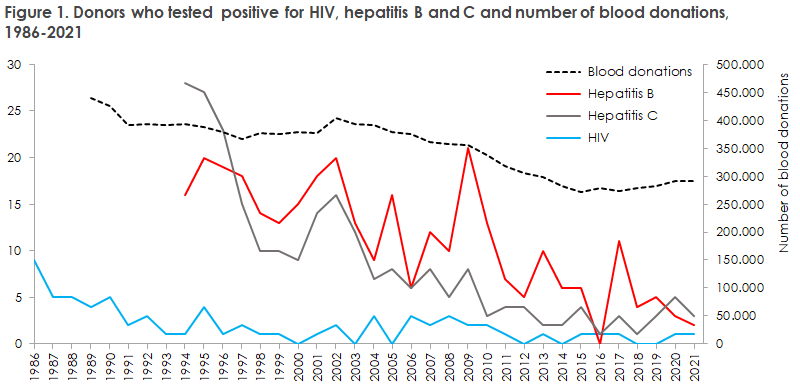No 34 - 2022
Whooping cough vaccination of pregnant women
Blood donor screening 2020 and 2021
Whooping cough vaccination of pregnant women
Following several requests regarding whooping cough vaccination of pregnant women, the SSI draws attention to the latest guidelines from the Danish Health Authority. Pregnant women are recommended vaccination between the end of week 24 and the end of week 32. Thus, the pregnancy visit in week 25 would be an obvious time to offer vaccination. Even so, the vaccine may be offered until one week before term. Furthermore, pregnant women are still recommended vaccination during all of their pregnancies, even if two pregnancies are separated by a short interval only.
The present temporary offer expires on 31 December 2022. Read more at our website (In Danish).
(Department of Infectious Disease Epidemiology and Prevention)
Blood donor screening 2020 and 2021
In 2020 and 2021, a total of 290,728 and 290,467 blood donations were screened, respectively. The number of positive donors is presented in Table 1. 2019 saw a total of 282,227 screened blood donations. Thus, the number of donations has barely declined despite the COVID-19-related lockdowns. Overall, some decline has, however, been observed since Statens Serum Institut started reporting this figure in 1989, Figure 1.

HIV
A single HIV-positive donor was detected in 2020 and one in 2021. One person was a first-time donor, whereas the other was a multiple donor whose latest donation had been given in 2017. Look-back was performed for three recipients (patients who had received blood from the donor); one recipient tested negative to HIV. All three recipients have died after receiving the donation (due to other causes than HIV). All donations were made beyond the window phase during which the donor could have been an unacknowledged positive. Therefore, no additional recipient tracing was performed.
Hepatitis B
Two persons tested positive to hepatitis B in 2020; three, in 2021. One person was a first-time donor. Furthermore, in 2020 and also in 2021, one person tested positive by NAT screening (nucleic-acid amplification technique) and would therefore not have been detected if only antibodies had been measured.
The remaining four donors who had become infected with hepatitis B were multiple donors. In 2020, look-back was performed for two recipients; one patient was not tested due to the patient’s current condition and age considered in conjunction with the fact that the patient had a low risk, and one patient tested hepatitis B negative. In 2021, look-back was performed for five patients: one was a terminal patient and was therefore not tested; in two recipients, clinicians did not report back, and two recipients tested hepatitis B negative.
Hepatitis C
In 2020 and 2021, five and three donors, respectively, tested positive to hepatitis C; three of the five from 2020 and two of the three from 2021 were first-time donors. Look-back was performed for one recipient who tested hepatitis C negative.
Commentary
The number and incidence of positive donors and the number of blood donations in Denmark remained low in 2020 and 2021, Figure 1.

Since 2011, between none and one HIV-positive person has been found in the blood donor corps. Until March 2000, men were excluded from the donor corps if they had engaged in sex with men at any time. This provision has now been changed. Men who have sex with men may donate blood provided they observe a four-month quarantine period. The period serves to avoid that a donor gives blood while in the so-called window phase, within which newly infected persons may test HIV negative even though their blood is infectious. A proposal has been presented regarding additional shortening of the HIV quarantine period.
The Department of Infectious Disease Epidemiology and Prevention holds information on screening of blood for HIV as from 1986, and for hepatitis B and C as from 1994, Figure 1.
The Danish Patient Safety Authority annually publishes “Report for the blood product area”, which describes in greater detail the blood transfusion area.
(A.K. Hvass, S. Cowan, Department of Infectious Disease Epidemiology and Prevention)
24 August 2022